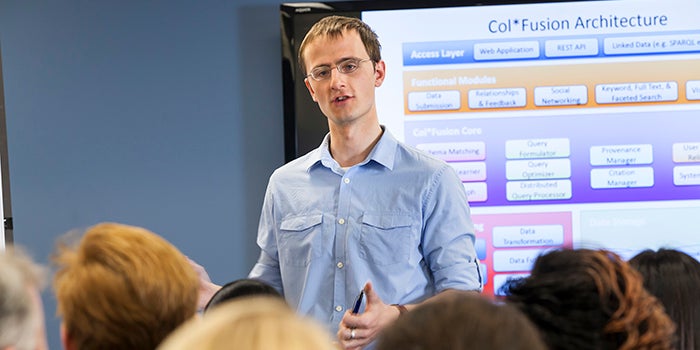
Meet three Pitt researchers who work and teach under the same departmental roof. First is Professor Konstantinos Pelechrinis, who explores how data can help sports teams analyze strategies. Next, we have Professor Michael Lewis, who studies teams of robots and people working in military applications. Finally, there’s Professor LingFei Wu, who analyzes how effective teams of scientists accelerate innovation.
All this research on “teams” (of different compositions and goals) comes together at Pitt’s School of Computing and Information, specifically at the Department of Informatics and Networked Systems (DINS), which operates at the conjunction of information, networks, and human behavior. Here, faculty and students of various disciplinary backgrounds and interests — like Pelechrinis, Lewis, and Wu — come together in the fields of information science and telecommunications to innovate technology to benefit the humans who use it.
Kelly Shaffer, DINS Department Manager, says the department can be mystifying to describe, because of all the various backgrounds and strengths of the people who constitute DINS. But this gives the department an edge.
“It’s a really cool place because, as a student, you’re going to take classes or you’re going to do a research project with incredibly diverse people,” Shaffer says. “You’ll learn so much because the faculty have such different perspectives.”
Any student interested in studying information across the three dimensions of data, networks, or people will find a home in the department. DINS programs start at the undergraduate level with the Bachelor of Science in Information Science (BSIS), which recently underwent a complete redesign to reflect the breadth and depth of knowledge necessary for the field. Graduate students can pursue a Master of Science in Information Science (MSIS), where, irrespective of background, students gather to design systems to benefit fields from health care to manufacturing. Others can earn a Master of Science in Telecommunications (MST) degree, where students learn to design and manage the networks that sustain communications services.
Advanced scholars can pursue doctoral degrees in Information Science, with or without a focus in Telecommunications. Certificates of advanced study ranging from 15 to 24 credits are also available in Information Science and Telecommunications, as well as Big Data Analytics, Cybersecurity, and Information and Network Security.
Prashant Krishnamurthy, DINS Department Chair, said the evolution of telecommunications, information science, and information security came together to define DINS’ mission. The three have grown increasingly connected over the years — just as technology has allowed humans to grow increasingly connected to each other.
“There are all these connections between things, where humans are connected to machines, devices are connected to devices, data entities are connected to other data entities,” Krishnamurthy says. “These connections allow us to solve problems from the human perspective that would not otherwise be possible.”
DINS graduates from all levels can be found in any profession imaginable, from Google and Apple to the Allegheny County Health Department. DINS grads receive an education that prepares them for success from a department that knows how to play to its wide-ranging strengths. And any student interested in information, networks, and security with a human lens will surely find their niche at SCI.
“It’s not a department of all the same people,” Shaffer says. “That’s what makes it such an interesting place to be.”
